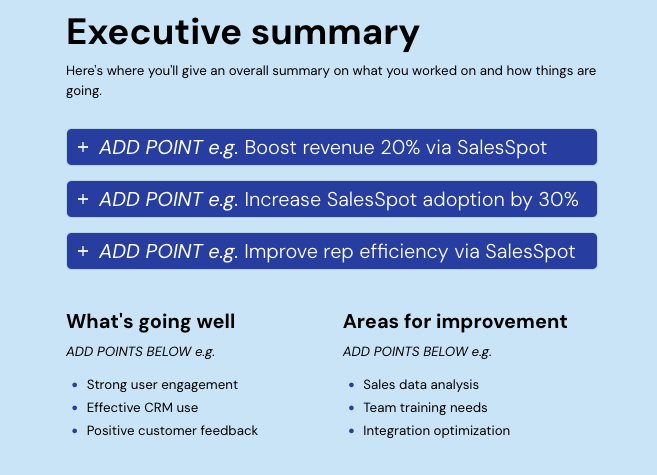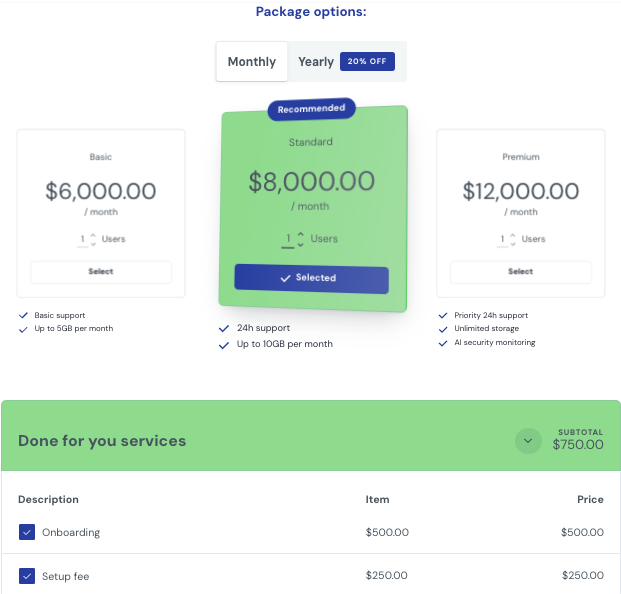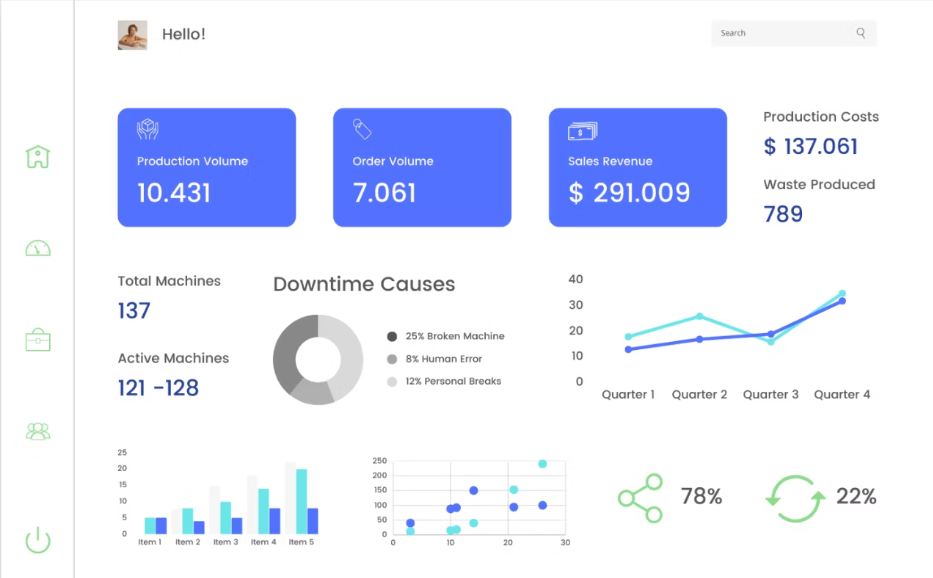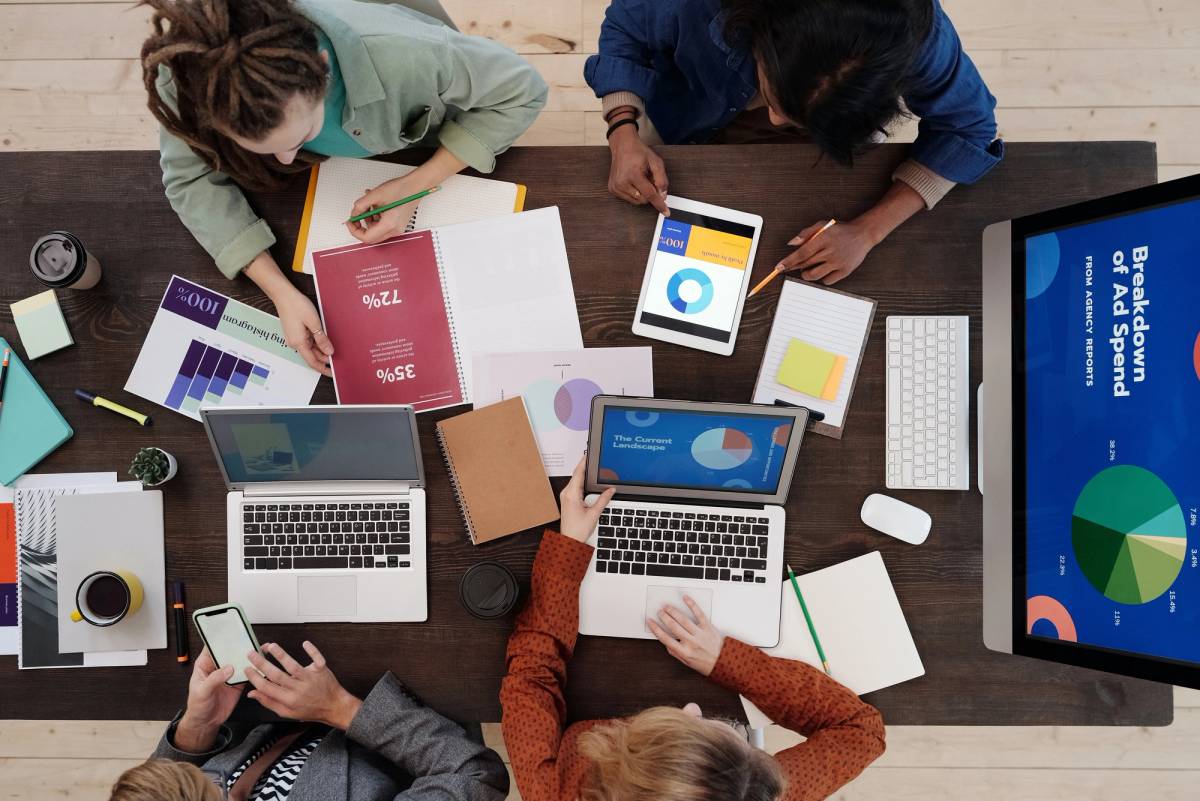We’ve all been there — competition is steep, and you’re looking for ways to strengthen client relationships. Quarterly business reviews (QBRs) are ideal for tightening these bonds.
QBRs allow you to check in with your clients, get on the same page, and realize your shared goals. They also allow you to grow your business while helping drive your client with theirs.
While striking this balance can be tricky, you’re not alone. We’re here to walk you through every aspect of a quarterly business review.
TLDR: Create a quarterly business review in a few minutes
What is a quarterly business review (QBR)?
A quarterly business review is an extensive document that covers your client’s growth, or lack thereof, over the previous three months.
Babar Javed, Chief Communications Officer at Z2C Limited explains:
“It is a status check activity between a business and its stakeholders to review the progress of goals and the upcoming targets, including how to get there.”
The QBR should highlight your organization's role as a partner in their growth. It should include:
- KPIs
- Progress toward KPIs
- Measurement tools used
- Depth and breadth of product or service usage
- Customer engagement
- Discussion of how/which strategies have contributed to growth
- Plans for the next quarter as it relates to the year
- Overview of your client’s mission, vision, and values as they relate to this report
In broad terms, the QBR reveals quarterly ROI and its connection to your company.
Javed expands by saying:
“The QBR helps keep everyone accountable and more importantly is a reminder that we're all on the same team, moving towards the same goal.”
Why you should conduct quarterly business reviews
QBRs offer a structured, scheduled opportunity to touch base with your clients. It reminds them, and you, what your relationship is built on, and why it’s continuing to work.
Here are just a few reasons to conduct QBRs:
Demonstrate value to clients
It’s not personal. Over time, your clients may find themselves wondering why they should stick with your company. They may have your competitors knocking on their doors and wooing them with flashy PowerPoint presentations. A QBR reminds your clients what you’re bringing to the table with your own flashy presentation.
Track progress and performance
Every company should be doing this anyway, but some just don’t have the time. Performance reports are a key element of a winning customer success strategy. They show your clients how far they’ve come in the last three months and even over the last year.
By preparing QBRs, you provide your clients with a service that will allow them to evaluate and reflect on their goals. This type of report is of tremendous value for businesses that want to track their progress. By creating this report for them, your company reveals itself to be a strong partner in their growth.
Foster alignment
The key term to remember here is “partner.” The QBR integrally connects your company with that of your client and builds a stronger B2B customer relationship. Your reports will show exactly how the services you provide relate to your client's growth and progress. You’re in this together.
Engage stakeholders
Often, high-level executives won’t engage in standard meetings with marketing, data, accounting, and human resources firms or with other vendors that provide services to their companies. QBR meetings are a way to schedule face time between your company's executives and those of your client. This shared experience has the potential to foster stronger relationships.
Proactive problem solving
It is rare for an entire quarter to go by without hiccups. Of course, issues will develop during that time, and a QBR is a great opportunity to address them. Rather than allowing months or years to go by while small problems become much larger ones, you can be proactive. Don’t try to hide, minimize, or cover up negative outcomes. Spend time on them in the meeting and present your plan to adapt and shift toward positive results.
Increased accountability
This ability to admit to poor performance and the demonstration of what’s working are examples of accountability. Your client will appreciate the fact that you hold yourself to a higher standard and can track these connections.
Your clients also get a chance to hold themselves accountable if they have not been following your guidance or implementing strategies. The numbers don’t lie.
Feedback loops and improved communication
It’s not enough to have a strategy. You need regular feedback on those strategies, and a QBR provides that feedback. It also enhances communication between you and your client. Open, honest discussions about what’s going well and what needs work create trust and engender loyalty.
Generate new sales opportunities
QBRs also open up new avenues for growth. During your meeting, you can offer new services or packages that your client needs now upon reflection. The sales pitch will feel seamless because it's either an offer to help your client scale up or to address a problem. Either way, you’re here to help.
Essential components of a QBR
Remember, your QBR will be an extensive report to present during a meeting with stakeholders in your client’s company. Each of the elements offers a point for reflection that you can discuss during the meeting and that your client can take away and use as an internal document.
Executive summary
The executive summary is the opening, high-level summary of what’s gone well, what hasn’t, and how your company is connected to these outcomes. In your presentation, you’ll include a specific point, like how much revenue has increased in a certain area of the client’s business, and you’ll relate it to a specific tool or service you’ve provided.
If you’re a marketing firm, for example, you can show an increase in sales from a targeted social media campaign. Then, you’ll reveal which strategies you used, what the graphics looked like, how much customer engagement you got, and so on.

Goals
The goals section of your report will reflect on what you and your client had previously discussed in terms of metrics. It will then showcase how far you’ve come in your partnership toward accomplishing those goals.
If, for example, you’re a Professional Employer Organization (PEO), you can discuss your client’s goals for employee retention and satisfaction. Then, you will provide the reports that show how your onboarding process, benefits administration, and payroll process have increased employee satisfaction based on employee surveys.
As Head of SEO at Skale, Stuart McGarrick, notes:
“Your QBR needs to focus on your client's core KPIs (the end goal for your engagement) and how this relates to your client's core OKR(s). The results should be compared in line with the expectations of the 3-month strategy, discussing what KPI changes occurred, explaining WHY they occurred and what changes need to be made to improve on those.”
Business recommendations
Along with the executive summary and goals discussions, you’ll make recommendations for improvement and/or continued growth. This is the point in the meeting where you can make a soft sales pitch for your services that benefit your client.
Perhaps they need a bigger ad push for campaigns. They might want to consider stronger benefits packages for their employees. Or maybe they need a universal data platform your company provides to streamline their data and better analyze it.
Whatever the issue, your company has a solution and a recommendation, like any good partner would.
Data
The data portion of your QBR is where you pull out the raw numbers that back up your discussions. Again, the numbers don’t lie. Look at the data from every angle in the context of your campaigns and strategies, and be sure to address how it could have gone differently.
Not everyone is great with data, even the highest-level executives. So, make sure you have someone in your QBR meeting who can translate the data into plain English in a helpful way. This is a teaching moment for you and your client, where you get to enlighten them rather than talk down to them.
Insights
Data analysis leads to insights. This part of the QBR opens up the conversation to make it collaborative. You’ve shown your client the numbers. Now discuss what those numbers mean to your client in their industry. How are their competitors doing, for example? What is your client’s market share?
Brainstorm insights with your client, being sure to offer some insights you came into the meeting with. Remember, you’ve seen the report; they haven’t.
Financial check-in
The financial check-in is where you’ll talk about ROI. You’ve built up to this point during your QBR meeting, and this is your centerpiece. Show your client how much they’ve invested in your company, where their money went toward campaigns, resources, tools, or packages of services, and how much they’ve gained in return.
This section is also a great area to sell them on addons for your services to meet current client demands while driving more revenue.
They’ll see the value of working with you here, so placing this discussion toward the end of the meeting is a way to remind them of how strong your partnership is as they walk away from the meeting.
You can provide stunning visuals in your reports that reveal how far your client has come in the last three months, carefully tracking progress along that timeline.

Qwilr’s interactive pricing elements allow you to clearly display investment options and add-on opportunities.
Next steps/road map
The final piece of a QBR meeting is your time to look ahead. Because you’ll be meeting again in three months, you want to create new benchmarks. Perform a brief overview of the entire meeting, sum up successes and failures, and lay out a plan to move forward.
This point in the meeting is where you can also make a slightly harder sales push for your products or services that can help your client scale up or improve upon a negative outcome.
Your QBR report should include a visual of a road map that includes your business recommendations and the expected progress over the next quarter.

Quarterly business review (QBR) template
To build an interactive, visually stunning QBR that will keep your client engaged, consider Qwilr’s QBR proposal template. The template is ready-to-use and completely customizable for an on-brand and client-tailored QBR.
It includes space for:
- Executive summary
- Goals summary
- Business recommendations
- Link to product pitch deck
- Embeddable data dashboard
- Pricing information
- ROI calculator
- Next steps
Expert tips on nailing your quarterly business review
Of course, a QBR meeting is so much more than just your template. You’ll need to be on your feet, moving around the room, showcasing slides in a PowerPoint presentation, and engaging with your client.
Here are some tips from our experts on how to nail this meeting every time.
Tailor your QBR for your audience
No client wants to feel like “just another number” in your organization. Make sure your QBR report and meeting are specific to your client. Essentially, tell them the story of your partnership, highlighting the power of your relationship and how it has impacted their market share.
Aside from a client-specific quarterly business review, consider who is going to be seeing this report and taking part in the meeting—executives, investors, or clients? Your QBR should reflect the goals and KPIs that resonate with your audience.
“Your QBR needs to cover the metrics that are the focus for each different audience. Understand that investors are not interested in vanity metrics and are concerned with company returns and market value, so this data needs to be conveyed. Executives don't necessarily want to understand the details, but want to see the metrics that align with their overall company goals and your QBR needs to reflect that.
Stuart McGarrick, Head of SEO
Strike a balance between reviewing past performance & setting future goals
It’s critical in your meeting that you neither focus on the past nor move quickly into the future. Celebrate wins, address losses, and be clear and direct about accountability. Then, move smoothly into your plan for the future, with powerful sales engagement, allowing the time and space for your client to buy in.
Take a note out of AE, Tallan Shrimpton's, book and dedicate one-third of the QBR to discuss past performance and two-thirds to focus on future goals.
Address challenges or underperformance
Do not shy away from problems. Trying to underplay or avoid poor performance will only make your client lose respect for you. You want them to hear about any challenges from you, with full accountability. Be open and honest and show them, with your QBR report visuals, why the problem occurred and how you plan to resolve it going forward.
Tallan Shrimpton, Senior Account Executive at Interact Software, recommends highlighting challenges and underperformance with objectivity:
“Don’t make it personal, use the data to quantify and position underperformance as an opportunity for improvement. Context is also key - highlight how other clients approach this challenge and make sure you acknowledge the variables that led to the underperformance.”
Use engaging language
Your QBR report and meeting should be drawn up and conducted by the storytellers in your company.
As Shrimpton says, “QBRs provide a touch point to build rapport.”
Use language that pulls your client in. Strong, powerful words like ideal, resolve, growth, confidence, and progress.
Remind your client that you’re in this together. Be authentic, transparent, and self-assured. You believe in your partnership, and you trust your plan to make it even better.
“Storytelling will help you illustrate the journey the client has gone on and put the progress you’ve made in context; it gives you the opportunity to revisit where you started and bring the emotional impact to light, in connection with the data you’re sharing.”
Tallan Shrimpton, Senior Account Executive
Weave in client feedback and insights
Make sure your QBR meeting includes feedback from your client. As Shrimpton advises, this meeting is a shared, inclusive environment where you should “Ask questions and make sure you’re discussing the topics and initiatives that are most important to the client at any given time.”
When you include your client in the discussion, you are more likely to get their buy-in — their willingness to move forward. They’ve come this far in business, so remind them that their insights are valuable too. They’ll help you do your job for them even better.
“Client feedback and insights are crucial to improve the performance, communication, and overall relationship. This cuts through any assumptions regarding success or failure, aligns future expectations, and are the foundations for all future strategies based on the previous quarter’s success and failures.”
Stuart Mcgarrick, Head of SEO
Include interactive elements
No one wants another boring meeting filled with pages and pages of text. Think of this meeting as an epic lecture hall with every student engaged. You’re the professor in this scenario, and it’s your job to keep your “students” awake and interactive.
One of the best ways to generate an interactive, involved experience is to include interactive elements in your report. Qwilr’s quarterly business review template offers interactive data dashboards, ROI calculators, and more that get your client engaged in the meeting.

Easily embed interactive elements in your web-based Qwilr proposals
Follow up after QBR
Of course, don’t forget to follow up after the QBR meeting. Ensure all relevant team members in your organization and your clients have access to the report. Send an email to your buyer champion at your client’s company a week after the meeting. Make sure you summarize your findings and ask for any further insights or ideas your client has come up with since the meeting. This follow-up maintains a strong connection and relationship between you and the client.
How to prepare for a quarterly business review meeting
Before going into this meeting with your report in hand, set yourself up for success by preparing. Here’s how to do that:
Prepare a detailed agenda
Outline an agenda with every element you’ll discuss. Take notes for your discussions, any stories you plan to tell, and points of humor or connection between you and your client. Get feedback and insight from your partners and the other executives at your company, and rehearse how you expect the meeting to go.
You should know the QBR report front and back and be prepared for any hiccups, pushback, or skepticism from your client.
Send your presentation to clients in advance
Your client may or may not have time to review the QBR report before your meeting, but send it anyway. You want them to feel included, like a partner, not blindsided by results they weren’t prepared for.
When you send the report at least a week in advance, you allow them to prepare feedback, questions, and insights. These can make the meeting more interactive.
Get feedback from your POC about what stakeholders will want to hear
Your point of contact at your client’s company will be the person who can help you prepare even better for the meeting. They are one of the core decision-makers. Ask for ideas and feelings about the report and the meeting in advance.
This feedback from your POC will help you prepare even more thoroughly for the meeting because you’ll understand your client’s expectations better.
“Ask questions beforehand to make sure you’re discussing the topics and initiatives that are most important to the client at any given time. Have a set process —set expectations in advance for the prep work needed to execute a strong QBR, and make sure clients know what their end of the bargain is, as well as how you’ll follow up and document the actions.”
Tallan Shrimpton, Senior Account Executive
Create a quarterly business review that impresses clients
A winning QBR can do wonders for your relationships with your clients. They are critical to the growth of your and your client’s businesses (and the sustainability of yours), so they hold value for the entire partnership.
Qwilr has designed beautiful, interactive templates perfect for creating your QBR and captivating your buyers. Sign up for a free trial today.
About the author

Brendan Connaughton|Head of Growth Marketing
Brendan heads up growth marketing and demand generation at Qwilr, overseeing performance marketing, SEO, and lifecycle initiatives. Brendan has been instrumental in developing go-to-market functions for a number of high-growth startups and challenger brands.


